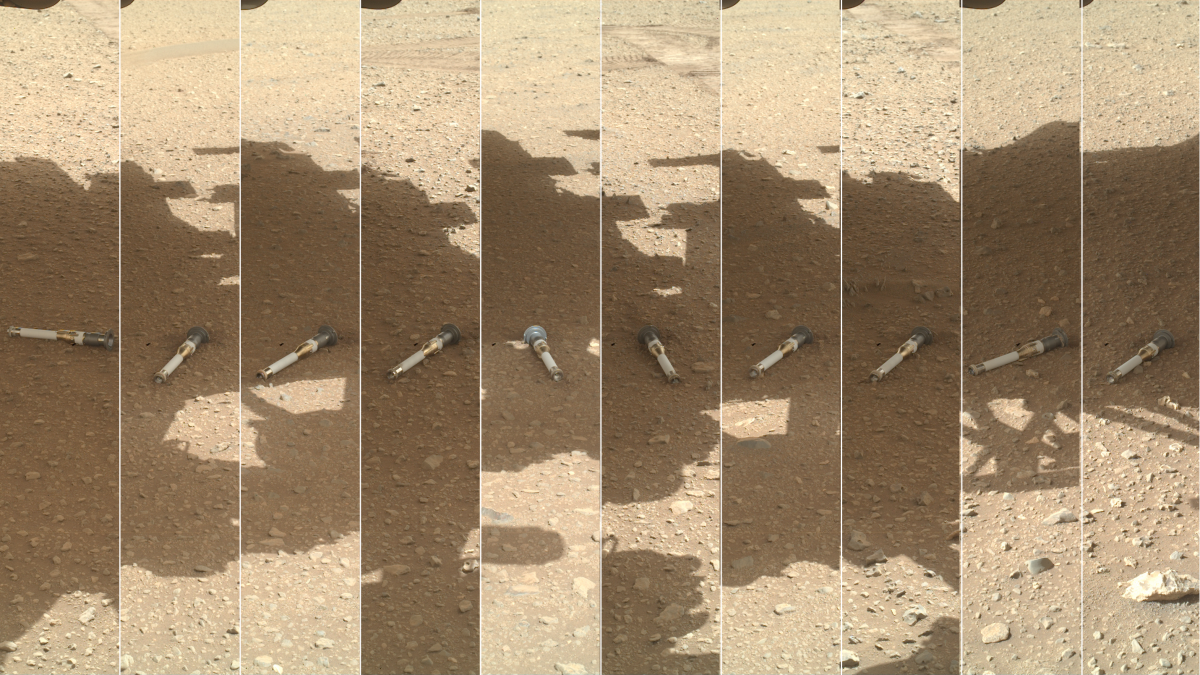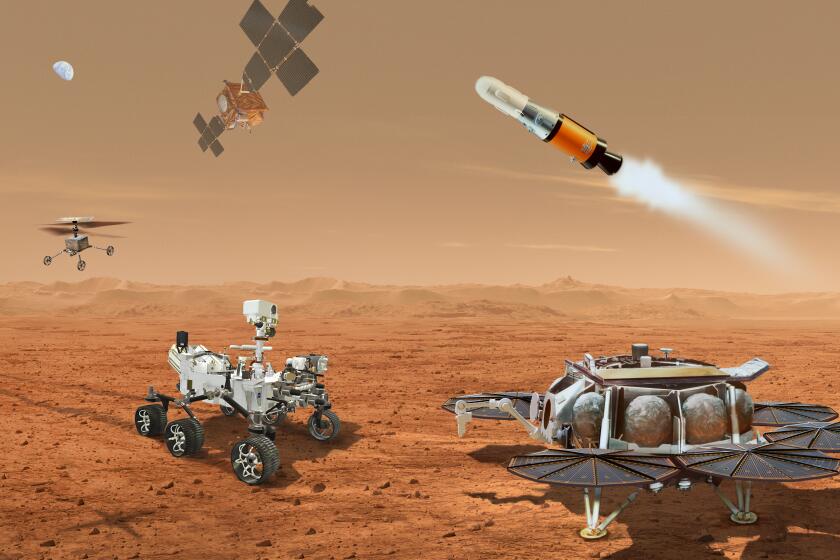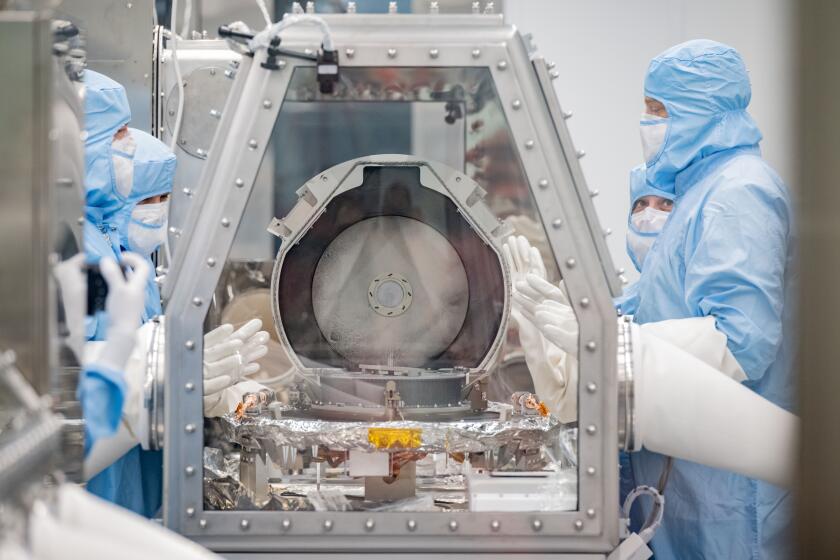Too expensive, too slow: NASA asks for help with JPL’s Mars Sample Return mission

After months of turmoil over the future of a vaunted mission to bring samples of the Red Planet back to Earth, NASA has its verdict on Mars Sample Return.
The space agency is “committed” to bringing those rocks back from Mars, Administrator Bill Nelson said Monday, but it will have to do it with way less money and in far less time than currently designed.
And how exactly is NASA going to pull that off? Right now it has no idea — and it’s looking for someone who does.
“I have asked our folks to reach out with a request for information to industry, to [the Jet Propulsion Laboratory] and to all NASA centers, and to report back this fall an alternate plan that will get [the samples] back quicker and cheaper,” Nelson said in a news conference at NASA headquarters.
His comments came in response to an independent review commissioned by NASA last year that declared there was “near zero probability” of Mars Sample Return making its proposed 2028 launch date, and “no credible” way to fulfill the mission within its current budget.
Pulling off the mission as designed would probably cost up to $11 billion, the review board found, with the samples not reaching Earth until at least 2040.
Could JPL’s ambitious Mars Sample Return mission use the long-troubled, massively over budget, but ultimately successful James Webb Space Telescope as a guide?
“The bottom line is that $11 billion is too expensive, and not returning samples until 2040 is unacceptably too long,” Nelson said. “It’s the decade of the 2040s that we’re going to be landing astronauts on Mars.”
NASA will direct $310 million to Mars Sample Return this year, less than half of the amount it’s allowed to spend on the project and a fraction of last year’s $822.3-million budget.
Next year, the agency will request just $200 million from Congress for the mission — a head-spinning drop from the $949 million the Biden administration wanted to invest in Mars Sample Return in March 2023.
The announcement comes as something of a blow to JPL, the La Cañada Flintridge institution tasked with managing the mission. JPL has already laid off more than 600 employees and 40 contractors this year after NASA ordered it to reduce spending in anticipation of budget cuts spurred by the challenges of Mars Sample Return.
Proposals go out soon to all NASA centers and the private aerospace sector for “a revised plan that utilizes innovation and proven technology to lower risks, to lower costs and to lower mission complexity so we can return these really precious samples to Earth in the 2030s,” said Nicky Fox, associate administrator of the Science Mission Directorate. The due date for proposals is next month, and those selected for further study will get NASA grants this summer.
This essentially puts JPL in a position of having to compete for its own project.
“Right now if JPL were to come up with the answer, then I’d say JPL is gonna be sitting pretty good,” Nelson said during Monday’s news conference. “But we’re opening this up to everyone because we want to get every new and fresh idea that we can.”
NASA’s decision to outsource a solution to the Mars Sample Return problem frustrated some Mars scientists.
“What I expected is for NASA to step up and say, ‘These things are hard and we choose to do them,’ ” said Bethany L. Ehlmann, a planetary scientist at Caltech. “That is the leadership required to be the nation leading the world in space exploration.”
Several members of California’s congressional delegation expressed dismay.
“I am disappointed that after eight long months of review on the Mars Sample Return mission, NASA is only just now issuing a call for studies on the best path forward,” Rep. Judy Chu (D-Monterey Park) said in a statement.
Lawmakers have lobbied to preserve JPL’s funding, citing the need to protect jobs and keep the U.S. space program competitive. China has announced a sample return mission of its own to launch in 2028 or 2030.
“These cuts will delay the mission at a critical time, further diminish our highly skilled workforce, and significantly undermine California’s Jet Propulsion Laboratory and our state’s globally leading science and space leadership as we face increasing competition with China,” California’s U.S. senators, Alex Padilla and Laphonza Butler, said in a joint statement.
“We strongly urge Administrator Nelson to work with Congress to better balance these cuts so that the JPL workforce is protected and the mission proceeds.”
Late last year, a spacecraft containing samples of a 4.6-billion-year-old asteroid landed safely in the desert after a 1.2-billion mile journey.
A joint project with the European Space Agency, Mars Sample Return would deliver rocks, rubble and dust that have already been gathered and sealed into tubes by the Perseverance rover.
The current design relies on a lander that would retrieve those tubes from the Red Planet’s Jezero crater and use a small rocket to ferry them into Martian orbit, where they would rendezvous with a spacecraft that would make the journey back to Earth. That craft would touch down on Earth roughly five years after the orbiter’s launch.
The ultimate goal is to comb the samples for evidence that life has ever existed on Mars, and to help NASA plan for future crewed missions, Nelson said.
In the most recent planetary science decadal survey — a report prepared for NASA every 10 years by the National Academies of Sciences, Engineering, and Medicine — planetary scientists named the Mars Sample Return mission as the “highest scientific priority of NASA’s robotic exploration efforts this decade” and argued that the program should be completed “as soon as is practicably possible with no increase or decrease in its current scope.”
But the authors cautioned that the ambitious mission shouldn’t come at the cost of other planetary science, suggesting a roughly $5-billion to $7-billion cap.
“Mars Sample Return is of fundamental strategic importance to NASA, U.S. leadership in planetary science, and international cooperation and should be completed as rapidly as possible,” the report stated. “However, its cost should not be allowed to undermine the long-term programmatic balance of the planetary portfolio.”
The agency is committing to keeping the mission within that recommended budget, Nelson said. Allowing Mars Sample Return’s costs to reach the $8 billion to $11 billion the review board estimated would require NASA “to cannibalize other programs, other science programs, and there are so many that are absolutely important,” Nelson said.
“JPL remains strongly committed to the Mars Sample Return mission, the highest priority in the past two planetary science decadal surveys,” the institution said in a statement.
“We will continue to contribute our unique capabilities to NASA and all partners to ensure mission success.”
With a final 2024 budget for NASA in place, the space agency has directed JPL not to cut any more staff working on the Mars Sample Return mission.










